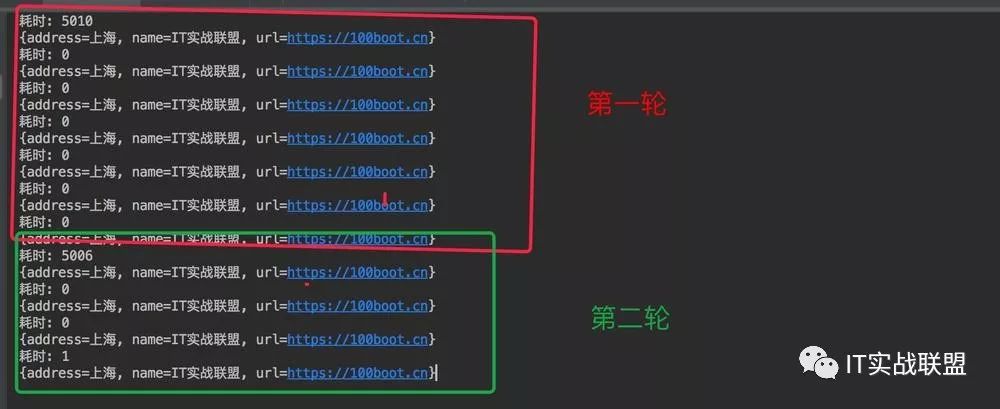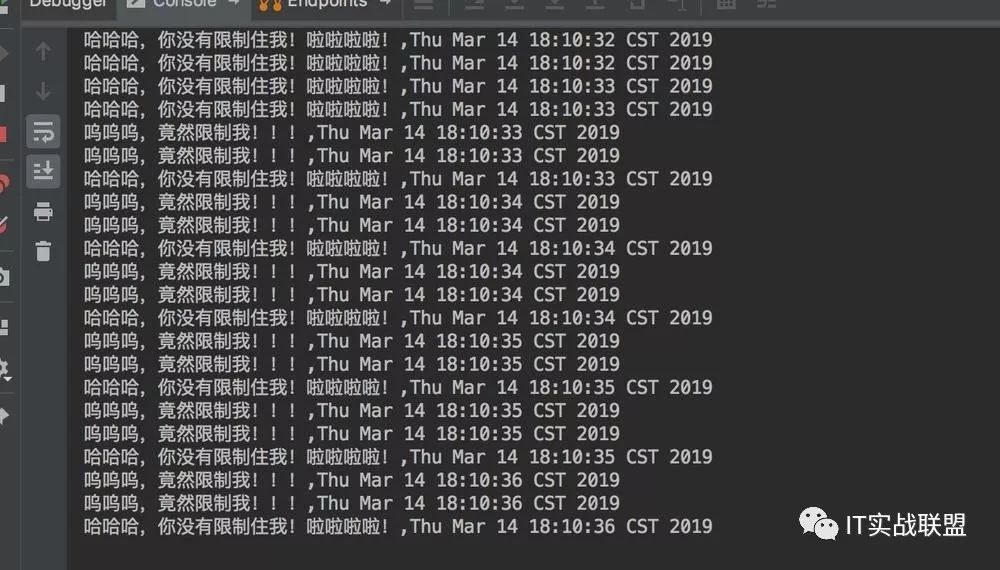简介
该项目主要利用Spring boot2.x + Guava 实现数据缓存,并使用RateLimiter做秒杀限流示例。
Guava是一种基于开源的Java库,其中包含谷歌正在由他们很多项目使用的很多核心库。这个库是为了方便编码,并减少编码错误。这个库提供用于集合,缓存,支持原语,并发性,常见注解,字符串处理,I/O和验证的实用方法。
Guava - RateLimiter使用的是一种叫令牌桶的流控算法,RateLimiter会按照一定的频率往桶里扔令牌,线程拿到令牌才能执行。
Google guava工具类快速入门指南
源码地址
GitHub:https://github.com/yundianzixun/spring-boot-starter-guava
码云:https://gitee.com/itunion/spring-boot-starter-guava
联盟公众号:IT实战联盟
我们社区:https://100boot.cn

小工具一枚,欢迎使用和Star支持,如使用过程中碰到问题,可以提出Issue,我会尽力完善该Starter
版本基础
Spring Boot:2.0.4
Guava:19.0
操作步骤
第一步:添加maven依赖
<dependency>
<groupId>org.springframework.boot</groupId>
<artifactId>spring-boot-starter-cache</artifactId>
</dependency>
<dependency>
<groupId>com.google.guava</groupId>
<artifactId>guava</artifactId>
<version>19.0</version>
</dependency>
第二步:增加GuavaCacheConfig 配置
GuavaCacheConfig.java
package com.itunion.guava.config;
import com.google.common.cache.CacheBuilder;
import org.springframework.beans.factory.annotation.Autowired;
import org.springframework.boot.context.properties.EnableConfigurationProperties;
import org.springframework.cache.CacheManager;
import org.springframework.cache.annotation.EnableCaching;
import org.springframework.cache.guava.GuavaCacheManager;
import org.springframework.context.annotation.Bean;
import org.springframework.context.annotation.Configuration;
import org.springframework.context.annotation.DependsOn;
import java.util.concurrent.TimeUnit;
/**
* Created by lin on 19/3/14.
*/
@EnableConfigurationProperties(GuavaProperties.class)
@EnableCaching
@Configuration
public class GuavaCacheConfig {
@Autowired
private GuavaProperties guavaProperties;
@Bean
public CacheBuilder<Object, Object> cacheBuilder() {
long maximumSize = guavaProperties.getMaximumSize();
long duration = guavaProperties.getExpireAfterAccessDuration();
if (maximumSize <= 0) {
maximumSize = 1024;
}
if (duration <= 0) {
duration = 5;
}
return CacheBuilder.newBuilder()
.maximumSize(maximumSize)
.expireAfterWrite(duration, TimeUnit.SECONDS);
}
/**
* expireAfterAccess: 当缓存项在指定的时间段内没有被读或写就会被回收。
* expireAfterWrite:当缓存项在指定的时间段内没有更新就会被回收,如果我们认为缓存数据在一段时间后数据不再可用,那么可以使用该种策略。
* refreshAfterWrite:当缓存项上一次更新操作之后的多久会被刷新。
* @return
*/
@DependsOn({"cacheBuilder"})
@Bean
public CacheManager cacheManager(CacheBuilder<Object, Object> cacheBuilder) {
GuavaCacheManager cacheManager = new GuavaCacheManager();
cacheManager.setCacheBuilder(cacheBuilder);
return cacheManager;
}
}
备注:duration 缓存项在指定的5秒钟内有效,超过试卷进行回收操作,具体时间根据业务配置;
第三步:增加GuavaProperties配置
GuavaProperties.java
package com.itunion.guava.config;
import org.springframework.boot.context.properties.ConfigurationProperties;
/**
* Created by lin on 19/3/14.
*/
@ConfigurationProperties(prefix = "guava.cache.config")
public class GuavaProperties {
private long maximumSize;
private long maximumWeight;
private long expireAfterWriteDuration;
private long expireAfterAccessDuration;
private long refreshDuration;
private int initialCapacity;
private int concurrencyLevel;
public long getMaximumSize() {
return maximumSize;
}
public void setMaximumSize(long maximumSize) {
this.maximumSize = maximumSize;
}
public long getMaximumWeight() {
return maximumWeight;
}
public void setMaximumWeight(long maximumWeight) {
this.maximumWeight = maximumWeight;
}
public long getExpireAfterWriteDuration() {
return expireAfterWriteDuration;
}
public void setExpireAfterWriteDuration(long expireAfterWriteDuration) {
this.expireAfterWriteDuration = expireAfterWriteDuration;
}
public long getExpireAfterAccessDuration() {
return expireAfterAccessDuration;
}
public void setExpireAfterAccessDuration(long expireAfterAccessDuration) {
this.expireAfterAccessDuration = expireAfterAccessDuration;
}
public long getRefreshDuration() {
return refreshDuration;
}
public void setRefreshDuration(long refreshDuration) {
this.refreshDuration = refreshDuration;
}
public int getInitialCapacity() {
return initialCapacity;
}
public void setInitialCapacity(int initialCapacity) {
this.initialCapacity = initialCapacity;
}
public int getConcurrencyLevel() {
return concurrencyLevel;
}
public void setConcurrencyLevel(int concurrencyLevel) {
this.concurrencyLevel = concurrencyLevel;
}
}
第三步:增加测试Guava缓存服务
CacheGuavaServiceImpl.java
@Cacheable(value = "guavacache")
@Override
public Map<String, String> getUserCache() {
new Thread().start();
while(true){
try {
Map<String,String> userMap = new HashMap<>();
userMap.put("name","IT实战联盟");
userMap.put("url","https://100boot.cn");
userMap.put("address","上海");
Thread.sleep(5000);
return userMap;
} catch (InterruptedException e) {
e.printStackTrace();
}
}
}
备注:在请求数据的时候 为了达到大数据的效果,这里设置了睡眠5秒的线程,5秒后返回结果
第四步:访问服务并命中guava缓存
CacheController.java
/**
* 查询缓存
*/
@ApiOperation(value = "getByCache", notes = "查询缓存")
@RequestMapping(value = "getByCache", method = RequestMethod.GET)
@ResponseBody
public String getByCache() {
Long startTime = System.currentTimeMillis();
Map<String,String> map = cacheGuavaService.getUserCache();
Long endTime = System.currentTimeMillis();
System.out.println("耗时: " + (endTime - startTime));
System.out.println(map.toString());
return map.toString();
}
第五步:测试效果

如上图所示:第一次请求耗费了5秒,接下来5秒钟内是直接命中guava从缓存里面获取的数据。5秒钟后进行了回收,再一次请求了服务并存储到guava中。
第六步:创建RateLimiter令牌限流服务
GuavaRateLimiterServiceImpl.java
/**
* 每秒钟只发出2个令牌,拿到令牌的请求才可以进入下一个业务
*/
private RateLimiter seckillRateLimiter = RateLimiter.create(2);
@Override
public boolean tryAcquireSeckill() {
return seckillRateLimiter.tryAcquire();
}
这里为了能够方便测试只设置了2个令牌。
CacheGuavaServiceImpl.java
@Override
@Transactional
public String executeSeckill() {
// 验证是否被限流器限制,如果没有,则继续往下执行业务
if(guavaRateLimiterService.tryAcquireSeckill()){
return "哈哈哈,你没有限制住我!啦啦啦啦!";
}else {
//被限流器限制
return "呜呜呜,竟然限制我!!!";
}
}
在使用RateLimiter令牌时,进行验证是否被限流器限制,如果没有则继续执行下面业务,如果被限制则直接返回不继续执行。
第六步:调用RateLimiter令牌限流服务
CacheController.java
/**
* 测试限流器
*/
@ApiOperation(value = "getRateLimiter", notes = "测试限流器")
@RequestMapping(value = "getRateLimiter", method = RequestMethod.GET)
@ResponseBody
public String getRateLimiter() {
String str = cacheGuavaService.executeSeckill();
System.out.println(str+","+new Date());
return str;
}
第七步:RateLimiter令牌限流服务测试

备注:由于手速原因可以看到每秒超过令牌个数的直接返回“呜呜呜,竟然限制我!!!”,说明有效果。

贡献者
IT实战联盟-Line
IT实战联盟-咖啡
往期回顾
微服务架构实战篇(四):Spring boot2.x + Mybatis +Druid监控数据库访问性能
微服务架构实战篇(三):Spring boot2.x + Mybatis + PageHelper实现增删改查和分页查询功能
微服务架构实战篇(二):Spring boot2.x + Swagger2 让你的API可视化
微服务架构实战篇(一):使用start.spring.io 构建SpringBoot2.x项目
Google guava工具类快速入门指南
---------------END----------------
后续的内容同样精彩
长按关注“IT实战联盟”哦

注意:本文归作者所有,未经作者允许,不得转载
